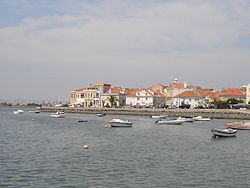Seixal
Seixal is a city of about 185,000 people (2011) near the Tagus River on the Setúbal Peninsula in Estremadura, Portugal.
Understand
[edit]

Seixal (say-SHAHL, /sɐj.ˈʃaɫ/) municipality has 158,269 residents (2011), with about 31,600 in the city proper.
Since the Roman era, the Tagus bay has been a region of human settlement, from many of the archaeological discoveries at Quinta do Rouxinol, in Corroios, and Quinta de S. João, in Arrentela (beginning in the period of the Portuguese Age of Discovery). A land of fishermen and seigneurial holdings, the municipality of Seixal evolved over the centuries, always with the connection to the river. It was across the Tagus that many of the region's products (fish, cereals, salt, olive oil, wine and fruits) were exported to the regional capital. In the 15th century, due to its prime location, various dockyards and shipbuilders began constructing river boats and trans-Atlantic ships. At the same time, the tides of the region were used to develop mills, such as the tidal mill in Corroios in 1403, fostering various the millers, caulkers and carpenters along the river. It was in Seixal that the brothers Vasco da Gama and Paulo da Gama built vessels for the trip to India. While Vasco da Gama was in Lisbon to prepare the trip, Paulo da Gama commanded carpenters and caulkers in the construction of the ships. Estêvão da Gama, the father of the brothers, was commander of Seixal. The construction of the ships was the beginning of what is known as the Portuguese Discoveries.
At the beginning of the 16th century, the population of the territory numbers three dozen homes, and by the 18th century there was a population of 400 inhabitants. By the 18th century, the municipality became an aristocratic retreat for the nobility in nearby Lisbon, resulting in the construction of several vacation villas, such as Quinta da Fidalga, Quinta do Alamo, Quinta da Trindade, Quinta de São Pedro and Quinta de Cheiraventos.
Around the bay, there are several factories that were important in the development of the municipality, such as the Fábrica de Vidros da Amora (Amora Glass Factory, the Companhia de Lanifícios da Arrentela (Arrentela Wool Co.), the Mundet Cork Factory in Seixal; and the cod drying buildings on the Ponta dos Corvos. These early factory installations transformed the municipality from a rural outpost into an industrial centre, eventually resulting in the installation of the steelmaker Siderurgia Nacional in 1961.
Visitor information
[edit]- 1 Posto Municipal de Turismo, Rua Sociedade União Seixalense, ☏ +351 212 275 732, [email protected]. M–F 09:00–12:30 & 14:00–17:30, Sa Su 09:30–12:30 & 13:30–17:30.
Get in
[edit]You can get there from Lisbon by car by crossing the 25th April Bridge and taking Highway 2.
You can take a boat from Cais do Sodré.
Lisbon is 15 km (9.3 mi) away, via the Fertagus train lines that connect Lisbon to Fogueteiro.
Seixal has bike paths along the bay that link Amora and Seixal, passing through the parishes of Seixal, Arrentela and Amora.
Get around
[edit]See
[edit]- 1 Quinta da Fidalga, Avenida da República 2571, Arrentela. Summer: Tu-Su 10:00-19:00; winter: Tu-Su 10:00-17:00. Vasco da Gama, the sailor who discovered the way to India by sea, lived in Seixal with his brother Paulo, on "Quinta da Fidalga". Its foundation dates back to the 15th century. It is one of the oldest and best preserved examples of farm and recreation farms in the region. Still in the 18th century, it stood out for its excellent orchards of citrus, streets covered with wild trees and vineyards in trellises. Two wells equipped with daisies provided water for irrigation. It is also distinguished by the tidal lake, which constitutes a rare or almost unique monument in Portuguese hydraulic architecture. It has a chapel that was integrated in the palace in the middle of the 20th century in place of an older one. The interior walls are lined with 18th century tiles and reproductions also from this period. Free.

- Visit the church (rebuilt after the 1755 earthquake)
- The Cultural Forum (with library, art gallery and auditory)
- The Eco-museum
- The Amora's Coreto
- The Moinho de Maré in Corroios
Do
[edit]- There is a river beach called Ponta dos Corvos.
- Avante! Festival. The primary event of the social year is the annual festival of Portuguese Communist Party, that attracts hundreds of thousands of visitors. The event consists of a three-day music festival with hundreds of Portuguese and international bands and artists on five different stages, in addition to ethnographic demonstrations, gastronomy, social debates, books and music fair, the Avanteatro (theatre) and sporting events. Several foreign communist parties also participate. The events preparation begins following the conclusion of the annual festivities, through the initiative of party members and youth volunteers.
Buy
[edit]- 1 RioSul Shopping, Avenida Libertadores de Timor Loro Sae (access by A2, EN10 and N378; Transportes Sul do Tejo: route 302 -- Fogueteiro/Baixa da Banheira station, route 184 -- Fogueteiro/Seixal (mercado) station), ☏ +351 21 221 95 00, [email protected]. 140 shops on 2 floors, 18 restaurants, 1 hypermarket, a terrace, a playground and free parking.
Eat
[edit]- Pizzaria Verde e Amarelo
- João de Ourique
- A Petisqueira
- Timbre de Sabores
- O Bispo
- Hamburgeria do Rio
- 1 Ferro Velho, Praceta Canquelifá 3, Cruz de Pau, Amora, ☏ +351 212 240 299, [email protected]. W–M 10:00–23:00, closed Tu. Traditional Portuguese restaurant specializing in seafood. €10-20.
Drink
[edit]At night you can have fun in the bars along the avenue along the river, in Amora.
Sleep
[edit]- 1 Evidência Belverde Hotel, Avenida de Belverde 70, Amora, ☏ +351 21 042 6900, [email protected]. Check-in: 15:00, check-out: 12:00. Four-star, 71-room hotel with indoor and outdoor swimming pools, spa, fitness centre, restaurant, room service, and bar. €64-108.


 Français
Français Italiano
Italiano




